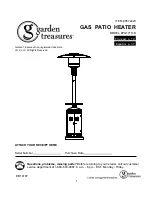
18
Do not move and do not cover the heater after it is switched off until it cools.
C. CYLINDER REPLACEMENT
PL EAS E N OT E!
•
The cylinder must be replaced in a room with no fire.
•
Please ensure the gas control system is in OFF position.
1.
After the heater has been turned off and cooled down, take the cylinder from the housing (first check the
cylinder valve is turned off!).
2.
Disconnect the pressure-reducing valve from the cylinder in accordance with the manual attached
to the pressure-reducing valve.
3.
Replace the cylinder.
4.
Connect the new cylinder, checking if no gas connections were loosened or damaged.
5.
Before connecting the pressure-reducing valve to the cylinder check if the gasket is present and
if it is in good condition.
6.
Leak test the system using e.g. soapy water.
IX. STORAGE
1.
Always close the gas cylinder valve after use or in the case of any troubles.
2.
If the heater is not to be used for a long time, disconnect the cylinder. Disconnect also the pressure-
reducing valve and hose.
3.
The cylinder must be stored outside the room, in a well-ventilated place out of reach of children.
4.
The disconnected cylinder must possess protections on the threaded connections and valve
and cannot be stored in the garage or another confined space.
5.
The heater can be stored at home solely after the cylinder has been disconnected and removed from
the heater.
6.
Check the gas valve for its tightness and possible damage. If the user suspects any damage, she should
have the gas provider replace it.
7.
Do not store the LPG cylinder in below-grade rooms, in multi-floor buildings and houses or in places
without the sufficient ventilation.
X. CLEANING AND MAINTENANCE
PL EAS E N OT E!
•
Do not carry out maintenance works after switching the heater off and before it cools down.
•
Ensure the gas supply has been disconnected and the gas control knob is in the OFF position.
•
Do not expose the starter, controllers and parts under the burner to water. Do not use
the heater if any of those parts was exposed to water until the device has been inspected
or repaired by the service technician.
Dirt, floccules or pollution can affect performance of the heater. The heater absorbs air during normal
operation. In that process the dirt, floccules or pollution will be absorbed into the heater and cobwebs will
form when the heater is not used. Keep the burner, gas control system, combustion and air circulation circuits
neat and tidy. Inspect the above-mentioned components or have them inspected by a qualified service
technician once a year at the beginning of the heating season. Room heater may require frequent cleaning due
to the accumulated floccules or other deposits depending on the operating environment.
A. CLEANING OF THE CERAMIC BURNER AND FUME ANALYSER
1.
Clean them outside with a soft bristle brush.
2.
Clean the fume analyser nozzle with compressed air to remove any dust.
3.
Do not use sharp objects as these may damage the nozzle.
B. AIR CIRCUITS AND HOUSING
1.
Clean the housing with a wet cloth. Do not clean the heater with any flammable or corrosive agents.
2.
Remove all the pollution, dust, cobwebs and insects' nests from the ventilation openings, control parts,
burner and air circulation circuits of the heater by means of a heavy-duty pipe cleaner or compressed
air to ensure the device is clean and safe to use. Do not clean the inlets or other openings with sharp,
















































